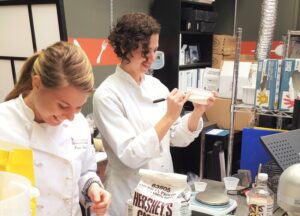By Dave Lundahl and Lesley Werblin
Translation requires more than providing promised functionality and a liked experience. It also requires tapping into the minds of consumers to understand what sensory qualities to build into a product as cues signaling the promise to be communicated implicitly and explicitly to shoppers and consumers. This important sprint in the CRAEVS solution fuses together these behavioral insights about cues that signal benefits with the knowhow of culinary food product developers for what qualities to build into products.
This fusing of this shopper/consumer and product knowledge comes together through a set of prototyping activities informed by co-design.
Co-design is a highly collaborative process between an innovation team and consumers for the purpose of translating your product concept. This collaboration with consumers comes within a series of rapid, iterative cycles of planning, prototyping, co-design testing, and back-room learning. Most co-design sprints take about three iterative cycles to complete, although strong working knowledge of a particular concept translation can reduce cycle requirements.
The initial co-design cycle starts with culinary product developers building an initial set of prototypes based on knowledge of key product attributes, raw materials, potential machinery and methods of production, and formulation strategies. This set of initial prototypes may also include working knowledge of co-manufacturer and ingredient sourcing constraints. The iterative series of co-design cycles gather feedback from participants on how to cull out or improve current prototypes.
 This co-design feedback drives the iterative learning of innovations teams’ ingredient choices and formats for the next cycle of planning, prototyping, feedback, and learning. The result is a set of sensory guardrails defining the range of product qualities (perceived in moments for shoppers at point of sale and/or for moments of use and consumption by consumers) that are associated implicitly as cues that signal higher level benefits and/or reasons to believe, and that ladder down to formulation and/or processing specifications. In addition, these cycles of co-design can include feedback on nutrition panels, ingredient declarations, allergen statements and possible FDA claims. At the end of these cycles of co-design, one or more gold standard prototypes are finalized and ready for validation and commercialization.
This co-design feedback drives the iterative learning of innovations teams’ ingredient choices and formats for the next cycle of planning, prototyping, feedback, and learning. The result is a set of sensory guardrails defining the range of product qualities (perceived in moments for shoppers at point of sale and/or for moments of use and consumption by consumers) that are associated implicitly as cues that signal higher level benefits and/or reasons to believe, and that ladder down to formulation and/or processing specifications. In addition, these cycles of co-design can include feedback on nutrition panels, ingredient declarations, allergen statements and possible FDA claims. At the end of these cycles of co-design, one or more gold standard prototypes are finalized and ready for validation and commercialization.
The co-design sprint of the CRAEVS process takes a disruptive concept aligned with a viable idea targeting an opportunity, and rapidly translates by building the product. This sprint sets up the next sprint in the CRAEVS solution for continued discussions with co-manufacturer finalists, ingredient sourcing, nutrition panels, and ingredient decks, allergen statements and possible FDA claims are finalized in preparation for pilot testing and scale up activities.





